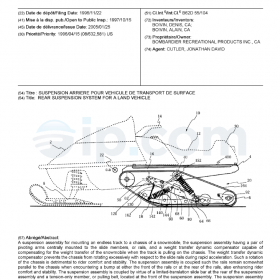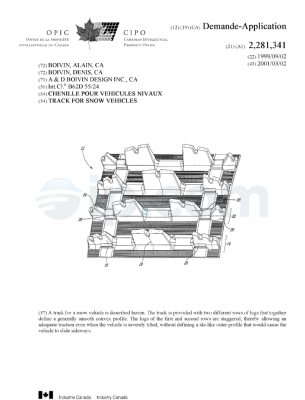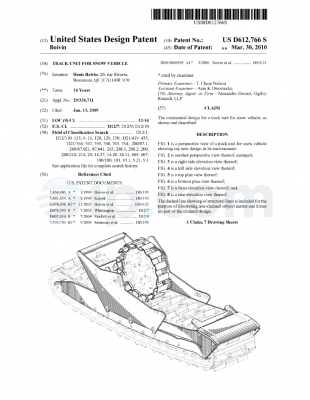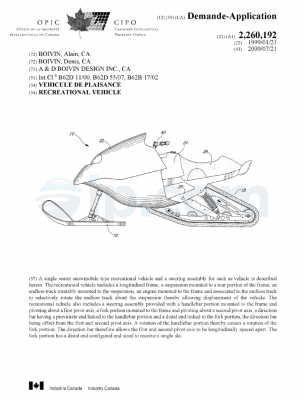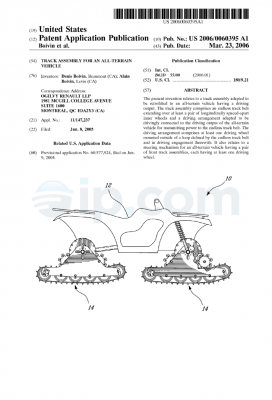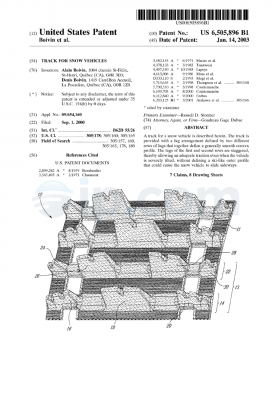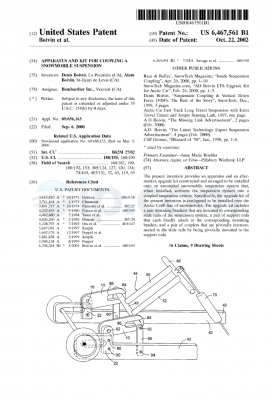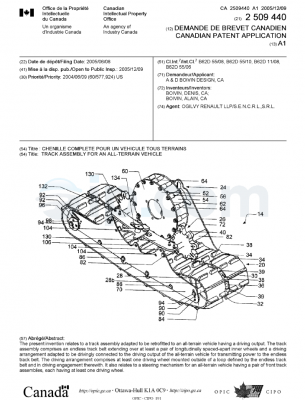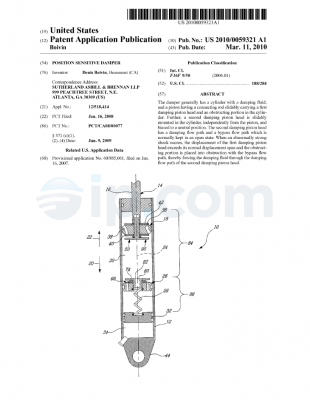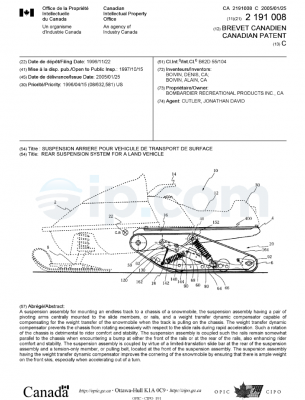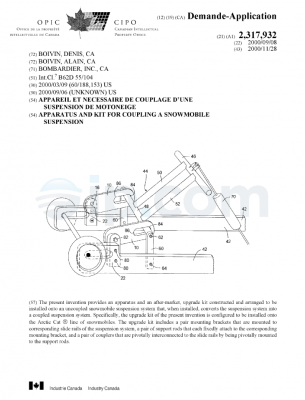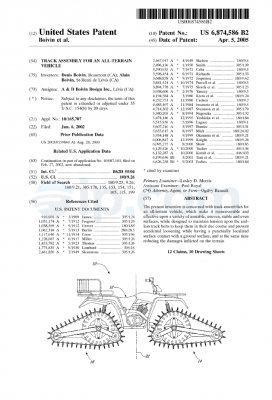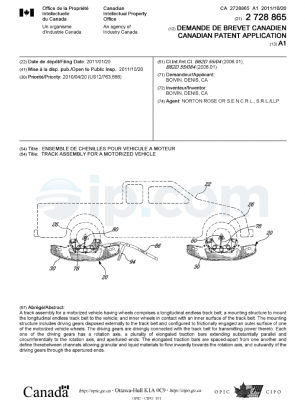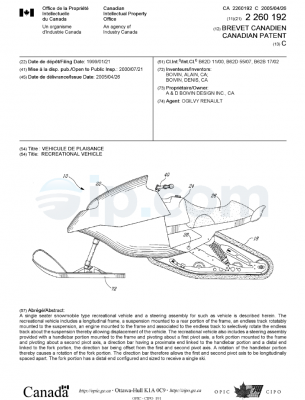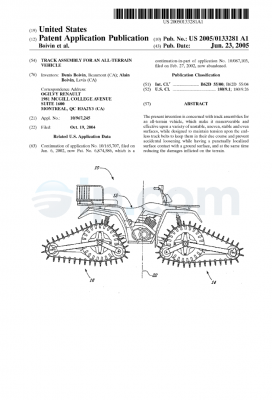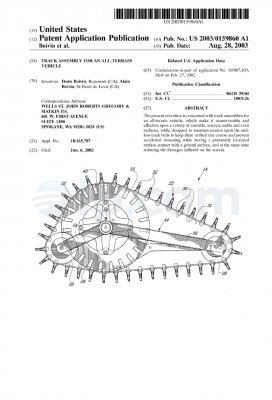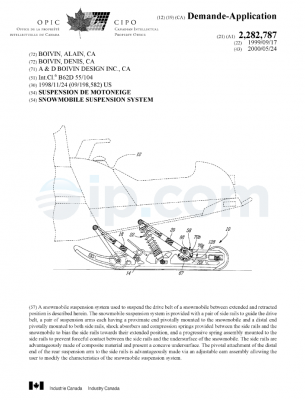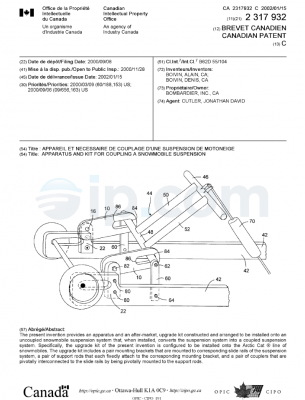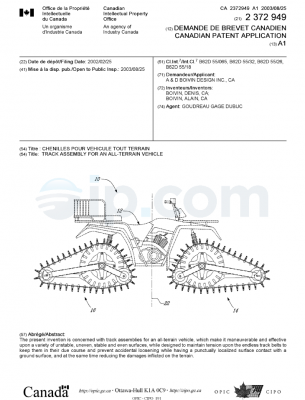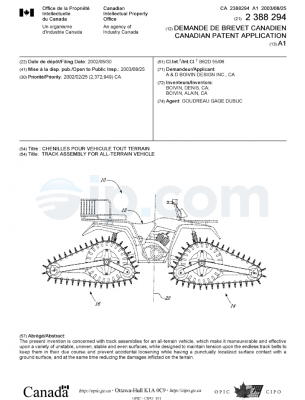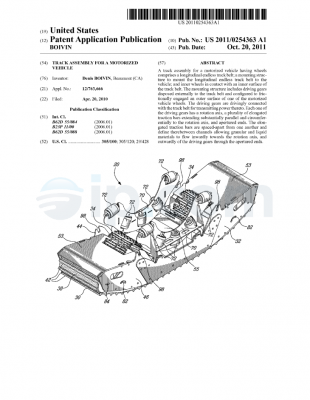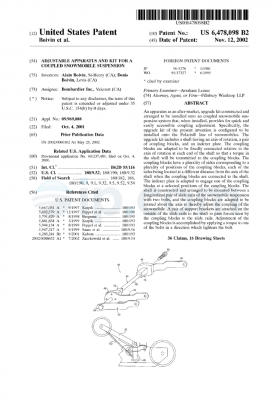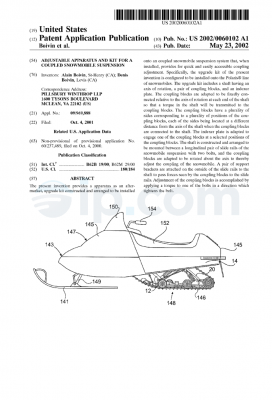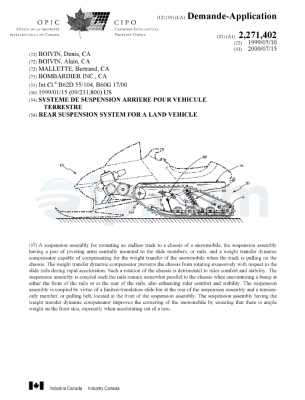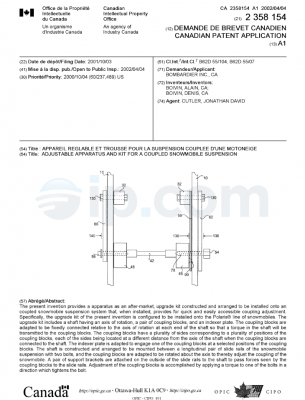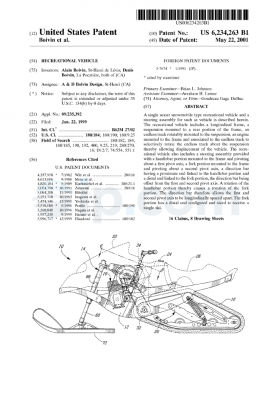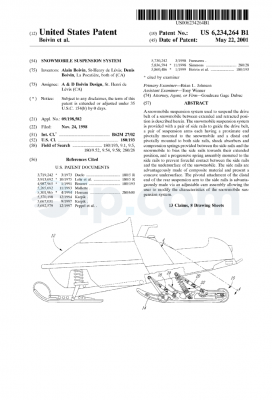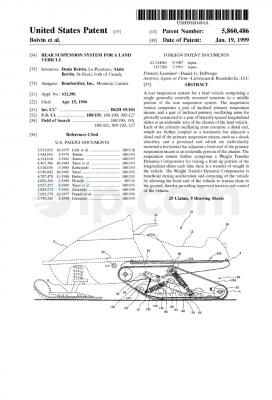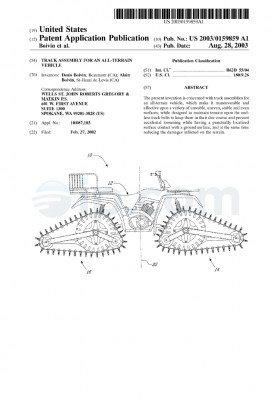CA 02191008 2001-04-20
Fig. 6a clearly i7_lustrates a side view of the bracket
86 comprising a plurality of angularly spaced-apart apertures
220, 222 and 224, arranged circumferentially around the third
horizontal bar’s aperture. The apertures are adapted to
receive securing means, such as nuts and bolts, for locking
the bracket 86 into a specific position. The bracket 86 can
further be rotated abou’~ the axis of the third horizontal bar
70, thereby altering the angle of inclination of the primary
suspenion means and securing the primary suspension means
l0 into a specified inclination.
As illustrated in Figs . 2 and 6a, the distal end of the
bracket 86 i.s adjacent t.o a distal portion of the travel
means 18, which further comprise a plurality of apertures
220, 222 and 224. Rotation of the bracket 86 further requires
adjustment and securir:g of the travel means 18 and the
corresponding apertures 220, 222 and 224. The primary
suspension me>.ans 80 m<~y be angularly positioned by attaching
the distal end 84 of the primary suspension means to one of
the apertures 220, 222 and 224. By positioning the primary
suspension means 80, the falling rate of the primary
suspension means is altered, as shown in Fig. 10.
In a further embodiment, the rear suspension system 20
comprises a Weight Transfer Dynamic Compensator (WTDC) for
– 15 –
CA 02191008 2001-04-20
maintaining the front E’nd of the vehicle in close proximity
to the ground surface, thereby providing an improved traction
for the entire vehicle . The features of the WTDC are clearly
illustrated in Fig. ?.The WTDC in combination with the
primary pivoting arms 60 and the primary suspension means 80
provides improved acceleration of the vehicle while
increasing travel of l~he rear suspension system 20. More
specifically, the WTDC further comprises a rod 110, a
secondary pivoting arm 120, and a pair of pulling belts 130,
l0 for providing further adjustment of the primary suspension
means 80 between alternative riding conditions. The rod 110
comprises a first end 1:L2 and a second end 114. The first end
of the rod 112 is attached to the first horizontal bar 40.
The first end of the rod 114 further comprises an aperture
therein for .receiving t:he first horizontal bar therein. The
second end of the rod 114 is attached to the secondary
pivoting arm 120 by means of a bolt. The secondary pivoting
arm 120 further comprises a first end 124 which is attached
to a fourth horizontal bar 75. The proximal end of the
secondary pivoting arm 124 comprises an aperture therein for
receiving the fourth horizontal bar 75 and is secured thereto
at a central area of t:he fourth horizontal bar 75. Finally,
the WTDC comprises a pair of pulling belts 130, one on each
lateral side of the ~;uspension system. The pulling belts
comprises lower ends 132 and upper ends 134. The lower ends
– 16 –
CA 02191008 2001-04-20
of the pulling belts 132 are attached to the rearwardly
mounted travel means 18 at a front portion thereof by means
of a fifth horizontal bar 78, as shown in FIG. 2, and the
upper ends of the pulling belts 134 are attached to the
fourth horizontal bar ’75 by an attachment means. The upper
ends of the pulling belts are attached to the fourth
horizontal bar at an interior portion thereof and adjacent
the primary pivoting ar~rns 60. The pulling belts function to
connect the suspension system 20 with the front portion of
the rear travel means, and insures that the front portion of
the rear travel means remains in close proximity to the
suspension system 20. Accordingly, the pulling belts of the
WTDC system pull down a front portion of the chassis while
maintaining t:he rearwardly mounted travel means 18 to remain
in contact with the around whenever there is a rearward
transfer of weight, notably during rapid forward
acceleration.
Alternatively, the suspension comprises a single pulling
belt 130 and an auxiliary limiting strap which would prevent
components of. the suspension from colliding with the endless
track in the unlikely event that the pulling belt 130 were to
break. The combination of the generally centrally mounted
suspension system and t=he WTDC allows for improved traction
of the vehicle. Fig. :Ll further illustrates the WTDC in
– 17 –
CA 02191008 2001-04-20
combination with the generally centrally mounted suspension
system. More specific:all.y, Fig. 11 is illustrative of the
primary elements of tlue WTDC: secured in two different
positions for differeni~ .riding conditions. The solid lines
represent the positioning of the rod and the secondary
pivoting arm in a standard position for comfortable
recreational touring whi_1_e the shadow lines represent the
position of t:he rod and the secondary
pivoting arm in a more
aggressive, racing position wherein the suspension
compensates for greatar weight transfer by allowing greater
travel in the mechanism..
The rear suspens:ic;n system 20 further comprises a
secondary suspension rr.e<~ns 140, having a proximal end 142 and
a distal end 144 as illustrated in Fig. l.The proximal end of
the secondary suspension means 142 is attached to a fifth
horizontal bar ‘l8, and the distal end of the secondary
suspension means 144 ha,~ing an aperture therein for receiving
a sixth horizontal bar 90 and being attached thereto. The
secondary suspension rr~ean~; 140 of the rear suspension system
20 may be a shock absc» ~ber. The secondary suspension means
140 work t=o <~bsorb shocks during movement or vertical weight
transfer of the vehicle.
– 1f3 –
CA 02191008 2001-04-20
In an alternative’ embodiment, the suspension system
comprises a longitudinal slide bar 150 located at a rear
portion of said vehicle, with the secondary suspension means
140 at a proximal portion of the vehicle being removed as
illustrated in Fig. 3.Th.e longitudinal slide bar 150 further
comprises a proximal a=nd 152 and a distal end 154. The
proximal end of the elide bar 152 has an aperture therein,
having a diameter of approximately 0.875 inches for receiving
the first horizontal bar 40 and securing the slide bar 150
l0 thereto. The distal end of the slide bar 154 has an elongated
aperture therein, having a width of approximately 1.375
inches and a radius ~~f curvature of approximately 1.000
inches, for receiving an eighth horizontal slide bar 94
adjacent a set of rear wheels of said vehicle at 300 in Fig.
5. In a preferred embodiment, the slide bar has a length of
24.50 inches, a width at: a midsection of 1.50 inches, and a
depth of 0.375 inches. As shown in Figs. 3 and 5,when the
rear suspension system 20 comprises the slide bar 150, the
rearwardly mounted travel means 18, such as a pair of
longitudinal slides 160, comprise a plurality of apertures at
300 for attaching the slide bar 150 to the rearwardly mounted
travel means 18. Figs. 12 and 13 further illustrate the
attachment of the sl.id.e bar 150 to the travel means. The
aperture at the distal end of the slide bar may be secured
without a gap (i.e. for a tight fit) between the aperture at
– 19 –
CA 02191008 2001-04-20
the distal end of the slide bar 154 and the attachment to the
longitudinal slide 160 at 300, as shown in Fig. 12. In this
arrangement, the slide bar cannot translate longitudinally.
Such a configuration provides for a stiffer riding of the
slide bar and the vel-iicle, as shown in zone 1 of Fig. 13.
Alternatively, the aperture at the distal end of the slide
bar 150 may be secured with a gap (i.e. in a sliding fit) of
0.250 inches between the aperture at the distal end of the
slide bar 154 and the attachment to the slide at 300, as
shown in Fig. 12. In this arrangement, the slide bar can
translate longitudinal_l~y within the elongated aperture. Such
a configuration provider for a softer riding of the slide bar
and the vehicle, as shown in zone 2 of Fig. 12. The
longitudinal slide bar 150 functions in a tension mode only,
and extends from the eighth horizontal bar 94 to the first
horizontal bar 40. They eighth horizontal bar 94 comprises
eccentric bolts for rotating the eighth horizontal bar and
thus adjusting the stiffness of the suspension system 20.The
slide bar 150 is held in tension, and maintains a constant
distance from the rear wheels 6 to the first horizontal bar
40, thereby transferring the force of an impact on the
suspension system to t:he primary suspension means 80. In a
preferred embodiment, the longitudinal slide bar 150 may be
comprised of a thermoplastic type material. However, instead
of a thermoplastic mat.=vial, the slide bar 150 may be made
– 20 –
CA 02191008 2001-04-20
from another material having suitable or similar quality and
strength, provided that: the material of the slide bar 150
enables it to accommodate the force of the suspension system
in a tension mode.
S
In an alternative embodiment, the slide bar 150 may be
replaced by a cable 150a or a strap (as illustrated in Fig.
3a) comprised of a material having suitable or similar
strength as that provided by the slide bar 150.
The forwardly and r_earwardly mounted travel means are
shown in the’ attached drawings as a pair of longitudinal
slides 160. In a pre:f:erred embodiment, the longitudinal
slides 160 comprise a ~~topper 162 at a proximal end of the
slide. The stopper 162 is preferably comprised of a rubber
material and is located on a top surface of the slide
adjacent the proximal end, so as to prevent the proximal
portion of the slide. from damaging the chassis and the
suspension system dur_~ng full extension of the primary
pivoting arms 60 and the primary suspension means 80. In
addition, the primary pivoting arms 60 comprise a stopper 68
at a midsection and on a top surface of the primary pivoting
arms. The stopper 68 is preferably comprised of a rubber
material, so as to prevent the primary pivoting arms from
damaging the chassis and the suspension system during full
– 21 –
CA 02191008 2001-04-20
extension of the primary pivoting arms and the suspension
system 20. Accordingly, stopper 162 and stopper 68 may be
made from another material. having suitable or similar quality
and strength to a rubber type material.
Figs. 1, 2 and 3 illustrate in detail a preferred
embodiment wherein t:h~= forwardl.y and rearwardly mounted
travel means 18 are in the form of longitudinal slides 160 of
a snowmobile. The travel means further comprise a flexible
endless track 164, for supporting the chassis, and a
plurality of wheels displaced along the length of the travel
means for enabling the endless track to move. The
longitudinal slides 16C are placed on an inside surface of
the endless track and support the rear suspension system 20.
In a preferred embodiment, the longitudinal slides may be
comprised of a metall_Lc type material, such as aluminum.
However, instead of aluminum, the longitudinal slides 160 may
be made from another metallic material having suitable or
similar quality and strength. The longitudinal slides 160
preferably comprises ~~ thickness of approximately 0.375
inches. An underside potion of the longitudinal slide, which
is in direct contact. with the endless track 164 of the
suspension system, preferably has a width of approximately
1.000 inches and a dept;lz of approximately 0.187 inches. The
underside portion of t:he slide is also comprised of a
– 22 –
CA 02191008 2001-04-20
metallic material, and preferably of an aluminum type
material. However, instead of aluminum, the underside portion
of the slide 160 may be comprised from another material
having a suitable or si.mi:lar quality and strength. The slide
further comprises a plurality of apertures disposed
throughout the length of the slide for receiving a plurality
of horizontal. bars fo:r attaching the longitudinal slides 160
to rear suspension system 20 of the vehicle 10.
As shown in Fig. 4, the centrally mounted primary
pivoting arms 60 of the rear suspension system provides for
improved maneuverabilit~~ of the rear suspension when compared
to the prioz- art. In a preferred embodiment, the primary
pivoting arms 60 are c~~mprised of a metallic type material,
and preferably of an aluminum material. However, instead of
aluminum, the primary pivoting arms 60 may be made from
another material having suitable or similar quality. The
arrangement of the primary pivoting arms 60 permits the
rearwardly mounted t:r~~vel means to rise vertically and
generally horizontally when bumps are encountered. The
primary pivoting arms 60 have a length of approximately 27.00
inches, a maximum width of 3.50 inches, and a depth of 0.25
inches. At a proximal E=_nd of the pivoting arms 62, there is
an aperture having a r<~dius of 1.250 inches for receiving a
second horizontal bar 50 and securing the primary pivoting
– 23 –
CA 02191008 2001-04-20
arm 60 to the chassis of the vehicle. A distal end of the
primary pivoting arm 64 comprises an aperture having a
diameter of approximate:Ly 1.50 inches for receiving the third
horizontal bar 70 and securing the distal end of the primary
pivoting arms 64 thereto.
Fig. 4 shows the primary pivoting arms 60 in several
different positions for a given snowmobile vehicle, wherein
each position depicted is dependent upon the weight being
applied to t=he suspen:~ion system 20. When the suspension
system is at rest, the vertical distance between a top
surface of the rear bumper 4 of the vehicle and the distal
end of the primary pivoting arms 64 is 19.892 inches.
However, when the suspension system is active and at its
maximum flexibility, the primary pivoting arms are in a
relatively horizontal position allowing for a vertical
clearance of at least. 11.500 inches from the ground to the
top surface of the rear bumper 4 of the vehicle. As is
further illustrated in shadow lines in Fig. 4, track tension
creates a compression of the rearward portion of the
suspension system. The pulling belts are able to pull down a
front portion of the chassis so that the rearwardly mounted
travel means remain generally horizontal and remain in
contact with the ground thereby maintaining good traction.
– 24 –
CA 02191008 2001-04-20
For purposes of completeness, the following is a chart
of the angle of displacement of the primary pivoting arms 60,
and the vertical distance from the distal end of the primary
pivoting arms 60 to a top horizontal surface of the rear
bumper 4 of the particular land vehicle given in this
example:
Angle of displacement Clearance
(degrees) (Inches)
18.92 8.392
26.52 12.219
34.43 16.784
When the suspension system 20 is in full extension, the
l0 minimum angle of displacement from the distal end of the
primary pivoting arm is 18.92 degrees, and when the
suspension system is at rest, the maximum angle of
displacement from the distal end of the primary pivoting arm
is 34.43 degrees.
The above description is of a generally centrally
mounted rear suspension system for a land vehicle, such as a
snowmobile. In an alternative embodiment, the suspension
system may be in the form of a kit separate from the vehicle
as a whole. The kit may be assembled and attached to a
conventional snowmobile and used to modify an already
existing suspension syst=em.
– 25 –
CA 02191008 2001-04-20
Although the present: invention has been described in
connection with preferred embodiments thereof, it will be
appreciated by those skilled in the art that additions,
deletions, modifications, and substitutions not specifically
described may be made without departing from the spirit and
scope of the invention as defined in the appended claims and
the scope should not b~~ limited to the dimensions indicated
hereinabove.
– 26 –


 English
English